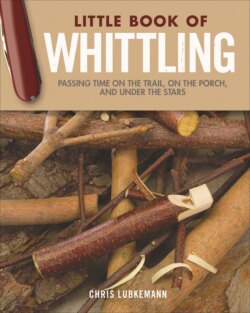Читать книгу Little Book of Whittling Gift Edition - Chris Lubkemann - Страница 8
INTRODUCTION
ОглавлениеFor many people, “whittling” conjures up quite a colorful image. It goes something like this: a fairly old codger with longish hair, wearing bib overalls and missing about a third of his teeth, sits in an old bentwood rocker on the front porch of a very weathered cabin located somewhere up in “them thar hills”—or several old codgers sit on stools around an old potbellied iron stove in the corner of a 125-year-old country store. In either case, there are piles of random wood shavings and chips in front of each stool or chair. Most importantly, there are the old, well-worn pocketknives and the even older and more worn hands that wield them. Go on—fill in the picture with even more details.
I’m sure a lot of whittling has indeed been done in the molds just described. And who is to say that some real benefits haven’t come from those front porch or round-the-stove sessions? While it’s probably true that in many cases all that was produced was a pile of chips and shavings with nothing but the knife left in the hands, I’m sure that on many other occasions what remained in the hand opposite the one holding the knife was an incredible work of art.
Throughout this book, you’ll notice tip boxes just like this one. Inside you’ll find information meant to add to your whittling experience—anything from methods for starting a fire to baits for fishing to recipes for the perfect s’mores. Also keep your eye out for little tips and facts at the bottom of many pages. Whether you’re on the trail, in camp, or at home, I hope that these tidbits evoke the fun and relaxing atmosphere that the ideal whittling experience will create. Oh, and be sure to check out some of my favorite tips throughout the book.
With these connotations of whittling and whittlers, it is easy to see why many whittlers/woodcarvers try too hard to define and to run away from certain terms. I’ve come across a number of folks in the woodcarving community who struggle with the word “whittle” and opt for the word “carve” because they want their work to be taken as serious art and not as the production of wood chips. Just for fun, I went to the dictionary that was closest at hand to see how it defined the word “whittle”. Here’s what I found: “to pare or cut off chips from the surface of (wood) with a knife” or “to shape or form by so paring or cutting.” I also looked up “carve”: “to make or shape by or as by cutting, chipping, hewing” and “to decorate the surface of with cut figures or designs.” Sounds like “whittle” and “carve” could almost be synonyms! True, the first definition of “whittle” could lend itself to the final product being just a pile of random chips on the floor, but the second definition certainly allows for all kinds of creativity and objects of genuine art.
Whittling is a very portable craft—you can take it just about anywhere. As you can see, it was a perfect way to pass the time while I was stuck in totally stopped traffic on I-81 in Virginia.
Today, whittling is alive and well and is certainly not limited to the characters, settings, or descriptions I’ve listed above. I would describe whittling as a simple type of woodcarving that involves a knife as its primary instrument. People of all ages, lifestyles, and levels of experience have enjoyed trying this simple and relaxing form of carving. Folks who have never carved a piece of wood will discover a new source of fun and satisfaction. Even old hands at woodcarving may find a few ideas that they’ll get a charge out of.
Aside from its relaxing effect, whittling has a number of other advantages. To start, the main raw material is free and, generally speaking, quite easy to find. (I don’t ever recall having to pay even a cent for one of the twigs or branches I’ve used over the past 39 years!) And as for the tools required and the few other materials and supplies, they’re simple, inexpensive, and very easy to get.
Also, whittling in general is a very “portable” craft. You can take it just about anywhere. That’s why I’ve designed this book as an outdoor companion. Whether you’re on the trail, sitting around the campfire, or just relaxing on the front porch, you’ll find lots of interesting facts, games, recipes, and more to keep you occupied between whittling projects. If you’re not as inclined to the outdoors, you can take your whittling to a number of indoor locations as well. I’ve whittled at commencement exercises, at wedding receptions, in barbershops, in doctor’s offices, and during totally stopped traffic jams, just to name a few.
So, relax, carve away, whittle, shape, form, whatever. Enjoy what you’re doing, and don’t worry if your finished project doesn’t turn out perfect or about any preconceived notions of whittling. My hope is that you’ll jump into the projects that follow and that they will provide you with fun, relaxation, and creativity and will “prime the pump” for other projects that this particular whittler has never even thought of !
Happy Whittling! Chris Lubkemann
